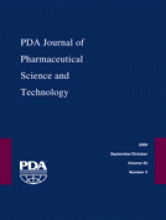Abstract
ASTM F2338-09 Standard Test Method for Nondestructive Detection of Leaks in Packages by Vacuum Decay Method is applicable for leak-testing rigid and semi-rigid non-lidded trays; trays or cups sealed with porous barrier lidding materials; rigid, nonporous packages; and flexible, nonporous packages. Part 1 of this series describes the precision and bias studies performed in 2008 to expand this method's scope to include rigid, nonporous packages completely or partially filled with liquid. Round robin tests using three VeriPac 325/LV vacuum decay leak testers (Packaging Technologies & Inspection, LLC, Tuckahoe, NY) were performed at three test sites. Test packages were 1-mL glass syringes. Positive controls had laser-drilled holes in the barrel ranging from about 5 to 15 μm in nominal diameter. Two different leak tests methods were performed at each site: a “gas leak test” performed at 250 mbar (absolute) and a “liquid leak test” performed at about 1 mbar (absolute). The gas leak test was used to test empty, air-filled syringes. All defects with holes ≥5.0 μm and all no-defect controls were correctly identified. The only false negative result was attributed to a single syringe with a <5.0-μm hole. Tests performed using a calibrated air leak supported a 0.10-cm3 · min−1 (ccm) sensitivity limit (99/99 lower tolerance limit). The liquid leak test was used to test both empty, air-filled syringes and water-filled syringes. Test results were 100% accurate for all empty and water-filled syringes, both without holes and with holes (5, 10, and 15 μm). Tests performed using calibrated air flow leaks of 0, 0.05, and 0.10 ccm were also 100% accurate; data supported a 0.10-ccm sensitivity limit (99/99 lower tolerance limit). Quantitative differential pressure results strongly correlated to hole size using either liquid or gas vacuum decay leak tests. The higher vacuum liquid leak test gave noticeably higher pressure readings when water was present in the defect. Both the ASTM F2338-09 test method and the precision and bias study report are available by contacting ASTM International in West Conshohocken, PA, USA (www.astm.org).
- Leak detection
- Leak test
- Container/closure integrity test
- Package integrity test
- Syringes
- Nonporous package
- Vacuum decay
- © PDA, Inc. 2009
PDA members receive access to all articles published in the current year and previous volume year. Institutional subscribers received access to all content. Log in below to receive access to this article if you are either of these.
If you are neither or you are a PDA member trying to access an article outside of your membership license, then you must purchase access to this article (below). If you do not have a username or password for JPST, you will be required to create an account prior to purchasing.
Full issue PDFs are for PDA members only.
Note to pda.org users
The PDA and PDA bookstore websites (www.pda.org and www.pda.org/bookstore) are separate websites from the PDA JPST website. When you first join PDA, your initial UserID and Password are sent to HighWirePress to create your PDA JPST account. Subsequent UserrID and Password changes required at the PDA websites will not pass on to PDA JPST and vice versa. If you forget your PDA JPST UserID and/or Password, you can request help to retrieve UserID and reset Password below.






